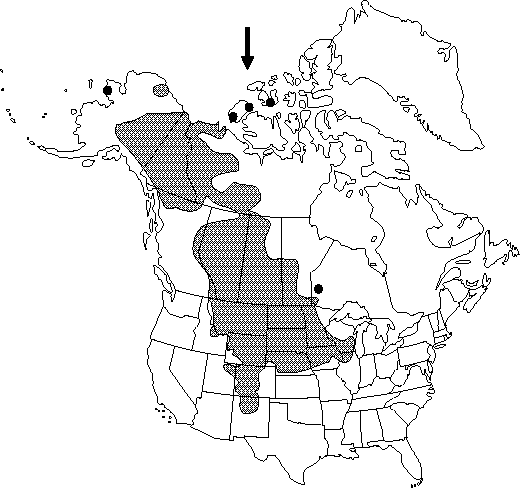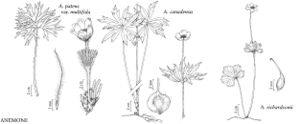Difference between revisions of "Anemone patens var. multifida"
Linnaea 15: 581. 1841.
FNA>Volume Importer |
RevisionBot (talk | contribs) m (Bot: Adding category Revised Since Print) |
||
| (6 intermediate revisions by 3 users not shown) | |||
| Line 10: | Line 10: | ||
|special_status={{Treatment/ID/Special_status | |special_status={{Treatment/ID/Special_status | ||
|code=F | |code=F | ||
| − | |label= | + | |label=Illustrated |
}} | }} | ||
|basionyms= | |basionyms= | ||
| Line 16: | Line 16: | ||
|name=Anemone patens var. nuttalliana | |name=Anemone patens var. nuttalliana | ||
|authority=(de Candolle) A. Gray | |authority=(de Candolle) A. Gray | ||
| + | |rank=variety | ||
}} {{Treatment/ID/Synonym | }} {{Treatment/ID/Synonym | ||
|name=Anemone patens var. wolfgangiana | |name=Anemone patens var. wolfgangiana | ||
|authority=(Besser) Koch | |authority=(Besser) Koch | ||
| + | |rank=variety | ||
}} {{Treatment/ID/Synonym | }} {{Treatment/ID/Synonym | ||
|name=Pulsatilla patens subsp. asiatica | |name=Pulsatilla patens subsp. asiatica | ||
|authority=Krylov & Sergievskaja | |authority=Krylov & Sergievskaja | ||
| + | |rank=subspecies | ||
}} {{Treatment/ID/Synonym | }} {{Treatment/ID/Synonym | ||
|name=Pulsatilla patens subsp. multifida | |name=Pulsatilla patens subsp. multifida | ||
|authority=(Pritzel) Zämelis | |authority=(Pritzel) Zämelis | ||
| + | |rank=subspecies | ||
}} | }} | ||
|hierarchy=Ranunculaceae;Anemone;Anemone patens;Anemone patens var. multifida | |hierarchy=Ranunculaceae;Anemone;Anemone patens;Anemone patens var. multifida | ||
| Line 43: | Line 47: | ||
--><p>Pasqueflower (as <i>Anemone patens</i> var. wolfgangiana) is the floral emblem of Manitoba and (as Pulsatilla hirsutissima) the state flower of South Dakota.</p><!-- | --><p>Pasqueflower (as <i>Anemone patens</i> var. wolfgangiana) is the floral emblem of Manitoba and (as Pulsatilla hirsutissima) the state flower of South Dakota.</p><!-- | ||
--><p>Native Americans used fresh leaves of <i>Anemone patens </i>var.<i> multifida</i> medicinally to treat rheumatism and neuralgia; crushed leaves for poultices; pulverized leaves to smell to alleviate headaches; and made decoctions from roots to treat lung problems (D. E. Moerman 1986).</p><!-- | --><p>Native Americans used fresh leaves of <i>Anemone patens </i>var.<i> multifida</i> medicinally to treat rheumatism and neuralgia; crushed leaves for poultices; pulverized leaves to smell to alleviate headaches; and made decoctions from roots to treat lung problems (D. E. Moerman 1986).</p><!-- | ||
| − | --><p>The names Pulsatilla hirsutissima (Pursh) Britton and <i>P. ludoviciana</i> | + | --><p>The names Pulsatilla hirsutissima (Pursh) Britton and <i>P. ludoviciana</i> A. Heller are illegitimate.</p> |
|tables= | |tables= | ||
|references= | |references= | ||
| Line 52: | Line 56: | ||
-->{{#Taxon: | -->{{#Taxon: | ||
name=Anemone patens var. multifida | name=Anemone patens var. multifida | ||
| − | |||
|authority=Pritzel | |authority=Pritzel | ||
|rank=variety | |rank=variety | ||
| Line 66: | Line 69: | ||
|publication title=Linnaea | |publication title=Linnaea | ||
|publication year=1841 | |publication year=1841 | ||
| − | |special status= | + | |special status=Illustrated |
| − | |source xml=https:// | + | |source xml=https://bitbucket.org/aafc-mbb/fna-data-curation/src/2e0870ddd59836b60bcf96646a41e87ea5a5943a/coarse_grained_fna_xml/V3/V3_243.xml |
|genus=Anemone | |genus=Anemone | ||
|species=Anemone patens | |species=Anemone patens | ||
| Line 73: | Line 76: | ||
}}<!-- | }}<!-- | ||
| − | -->[[Category:Treatment]][[Category:Anemone patens]] | + | --> |
| + | |||
| + | [[Category:Treatment]] | ||
| + | [[Category:Anemone patens]] | ||
| + | [[Category:Revised Since Print]] | ||
Latest revision as of 19:34, 6 November 2020
Aerial shoots 5-40(-60) cm, from caudices, caudices ascending to vertical. Basal leaves (3-)5-8(-10), primarily 3-foliolate with each leaflet dichotomously dissected; petiole 5-10(-13) cm; terminal leaflet petiolulate to nearly sessile, obovate in outline, (2.5-)3-5 cm, base narrowly cuneate, margins dichotomously dissected throughout, apex acute to obtuse, surfaces villous, rarely glabrous; lateral leaflets 3-4×-parted (±dichotomously); ultimate segments 2-4 mm wide. Inflorescences 1-flowered; peduncle villous or glabrate; involucral bracts primarily 3, 1-tiered, simple, dissimilar to basal leaves, (2-)2.5-4 cm, bases clasping, connate, margins deeply laciniate throughout, surfaces villous, rarely glabrous to nearly glabrous; segments usually 4-6, filiform to linear, unlobed, 1-2(-3) mm wide. Flowers: sepals 5-8, blue, purple, to rarely nearly white, oblong to elliptic, (18-)20-40 × (8-)10-15 mm, abaxially villous, adaxially glabrous; petals present; stamens 150-200. Heads of achenes spheric to ovoid; pedicel 10-18(-22) cm. Achenes: body ellipsoid to obovoid, 3-4(-6) × ca. 1 mm, not winged, villous; beak curved, 20-40 mm, long-villous, plumose. 2n=16.
Phenology: Flowering spring–summer (Apr–Aug).
Habitat: Prairies, open slopes, sometimes open woods or granite outcrops in woods
Elevation: 100-3800 m
Distribution

Alta., B.C., Man., N.W.T., Ont., Sask., Yukon, Alaska, Colo., Idaho, Ill., Iowa, Minn., Mont., Nebr., N.Mex., N.Dak., S.Dak., Utah, Wis., Wyo., Eurasia.
Discussion
Anemone patens var. multifida has frequently been recognized as a subspecies of A. patens. Although A. patens var. wolfgangiana has been used by some authors, A. patens var. multifida has priority.
Pasqueflower (as Anemone patens var. wolfgangiana) is the floral emblem of Manitoba and (as Pulsatilla hirsutissima) the state flower of South Dakota.
Native Americans used fresh leaves of Anemone patens var. multifida medicinally to treat rheumatism and neuralgia; crushed leaves for poultices; pulverized leaves to smell to alleviate headaches; and made decoctions from roots to treat lung problems (D. E. Moerman 1986).
The names Pulsatilla hirsutissima (Pursh) Britton and P. ludoviciana A. Heller are illegitimate.
Selected References
None.
